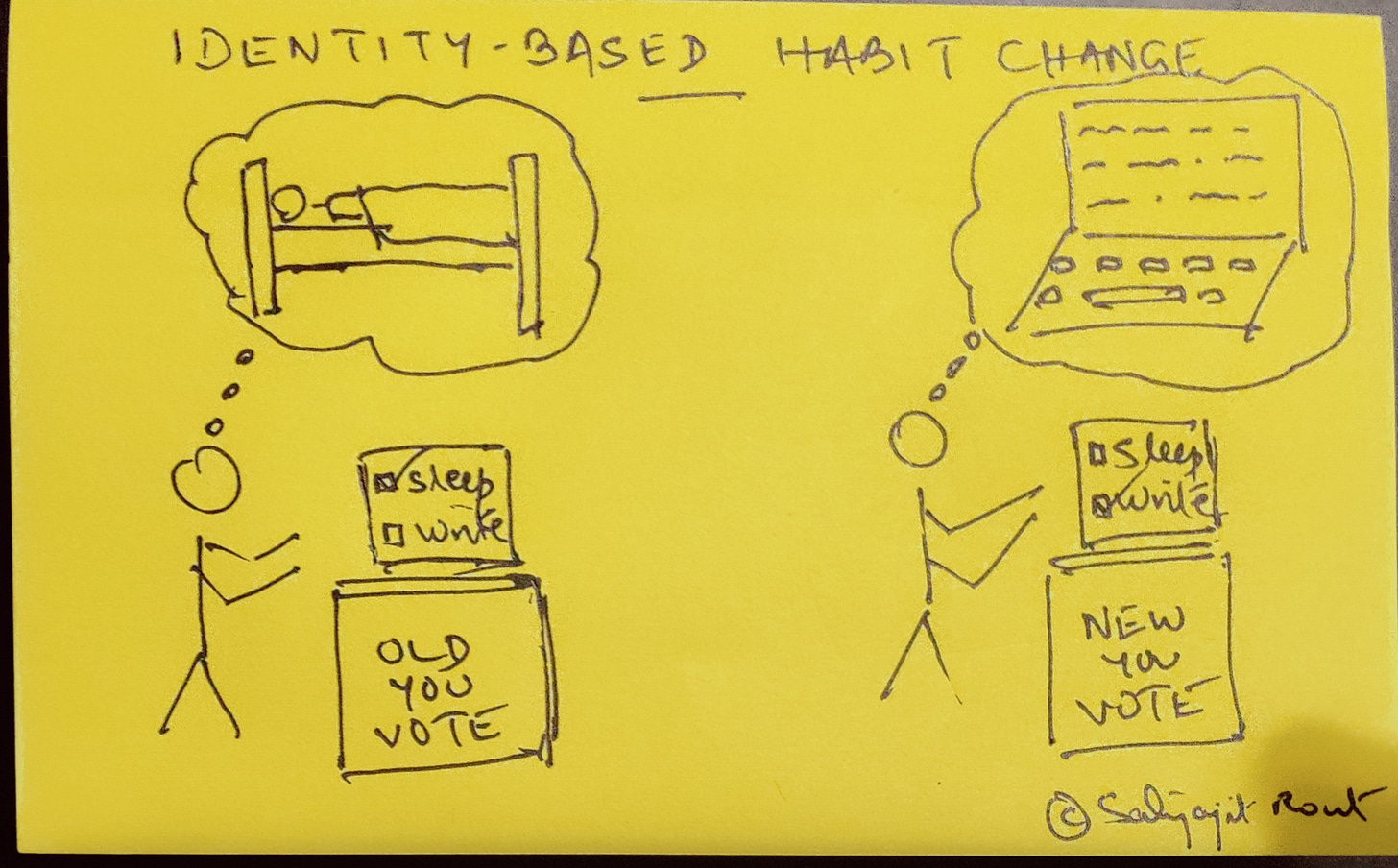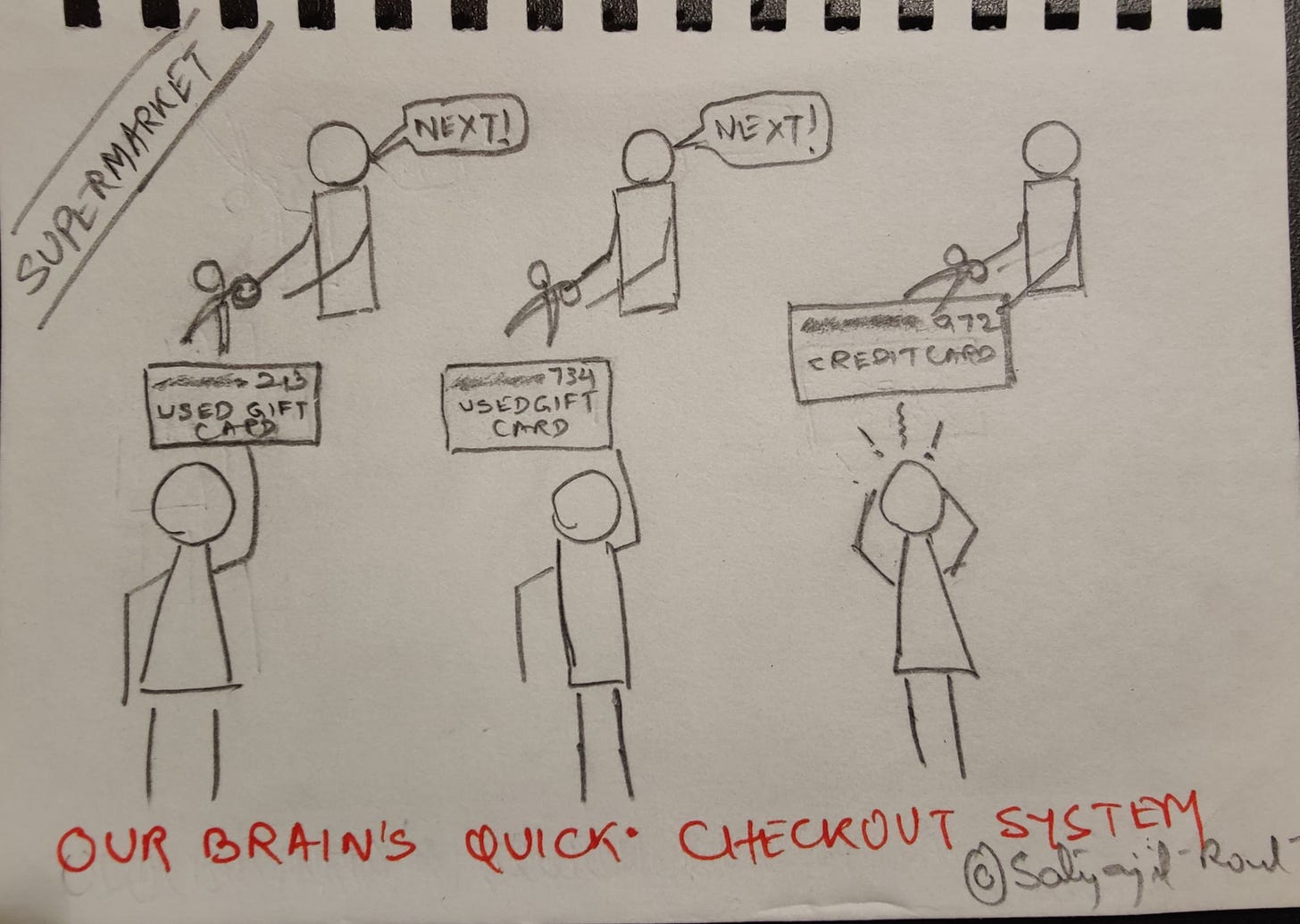Building lasting habits and breaking down big decisions
Identity-based habits AND decision breakdown steps
Part I: How to build a lasting habit
If you want to build a lasting habit, ask yourself: ‘𝐖𝐡𝐨 𝐚𝐦 𝐈 𝐯𝐨𝐭𝐢𝐧𝐠 𝐭𝐨 𝐩𝐨𝐰𝐞𝐫?’
I had good grades through school. They started falling in freshman year. ‘I’m smart,’ I reassured myself. I waited for things to change.
Nothing did. My friends were the brightest young minds in the country. I was no longer smarter. But because I identified as smart, I did what I had always done: I worked only when I had to. For short bursts, I pushed myself but in the face of sketchy results, I lost motivation.
What happened?
𝐈 𝐡𝐚𝐝 𝐭𝐫𝐢𝐞𝐝 𝐭𝐨 𝐜𝐡𝐚𝐧𝐠𝐞 𝐦𝐲 𝐡𝐚𝐛𝐢𝐭𝐬 (𝐬𝐭𝐮𝐝𝐲 𝐦𝐨𝐫𝐞 𝐫𝐞𝐠𝐮𝐥𝐚𝐫𝐥𝐲) 𝐰𝐢𝐭𝐡𝐨𝐮𝐭 𝐜𝐡𝐚𝐧𝐠𝐢𝐧𝐠 𝐦𝐲 𝐢𝐝𝐞𝐧𝐭𝐢𝐭𝐲 (𝐧𝐨𝐭 𝐬𝐦𝐚𝐫𝐭 𝐛𝐮𝐭 𝐡𝐚𝐫𝐝-𝐰𝐨𝐫𝐤𝐢𝐧𝐠).
Our identities are powerful forces. At the very basic, they are labels. At their core, they carry a force that can hold us back or propel us forward.
James Clear, author of Atomic Habits, suggests approaching habit change by building your desired identity first. See yourself as an athlete and you’ll run, good day or bad.
He compares building a habit to voting to power the person you want to become. The present you is in power today but the new you can win by collecting more votes. Votes are actions. Persist with good actions and the votes for the new you stack up. You’re on track to topple the incumbent!
Now imagine the campaign without your future self. There’s only one candidate–the current you. You don’t like her but in the absence of an alternative, the status quo prevails. That is what had happened to the freshman me.
𝐓𝐢𝐩 1: 𝐈𝐝𝐞𝐧𝐭𝐢𝐭𝐢𝐞𝐬 𝐰𝐨𝐫𝐤 𝐟𝐨𝐫 𝐛𝐮𝐢𝐥𝐝𝐢𝐧𝐠 𝐡𝐚𝐛𝐢𝐭𝐬 𝐛𝐞𝐜𝐚𝐮𝐬𝐞 𝐭𝐡𝐞𝐲 𝐞𝐬𝐭𝐚𝐛𝐥𝐢𝐬𝐡 𝐫𝐮𝐥𝐞𝐬 𝐭𝐡𝐚𝐭 𝐟𝐫𝐞𝐞 𝐮𝐩 𝐲𝐨𝐮𝐫 𝐝𝐞𝐜𝐢𝐬𝐢𝐨𝐧-𝐦𝐚𝐤𝐢𝐧𝐠. 𝐈𝐟 𝐲𝐨𝐮 𝐬𝐞𝐞 𝐲𝐨𝐮𝐫𝐬𝐞𝐥𝐟 𝐚𝐬 𝐚 𝐰𝐫𝐢𝐭𝐞𝐫, 𝐲𝐨𝐮 𝐰𝐚𝐤𝐞 𝐮𝐩 𝐞𝐯𝐞𝐫𝐲 𝐦𝐨𝐫𝐧𝐢𝐧𝐠 𝐚𝐧𝐝 𝐰𝐫𝐢𝐭𝐞. 𝐍𝐨 𝐡𝐢𝐭𝐭𝐢𝐧𝐠 𝐬𝐧𝐨𝐨𝐳𝐞 𝐚𝐧𝐝 𝐭𝐞𝐥𝐥𝐢𝐧𝐠 𝐲𝐨𝐮𝐫𝐬𝐞𝐥𝐟 𝐭𝐡𝐚𝐭 𝐲𝐨𝐮’𝐯𝐞 𝐛𝐞𝐞𝐧 𝐠𝐨𝐨𝐝 𝐚𝐥𝐥 𝐰𝐞𝐞𝐤.
𝐓𝐢𝐩 2: 𝐓𝐡𝐞 𝐯𝐨𝐭𝐢𝐧𝐠 𝐬𝐲𝐬𝐭𝐞𝐦 𝐡𝐚𝐬 𝐚 𝐬𝐞𝐜𝐨𝐧𝐝𝐚𝐫𝐲 𝐛𝐞𝐧𝐞𝐟𝐢𝐭. 𝐈𝐭 𝐚𝐥𝐥𝐨𝐰𝐬 𝐲𝐨𝐮 𝐭𝐨 𝐛𝐞 𝐤𝐢𝐧𝐝 𝐭𝐨 𝐲𝐨𝐮𝐫𝐬𝐞𝐥𝐟. 𝐘𝐨𝐮 𝐝𝐨𝐧’𝐭 𝐡𝐚𝐯𝐞 𝐭𝐨 𝐰𝐢𝐧 𝐚𝐥𝐥 𝐭𝐡𝐞 𝐯𝐨𝐭𝐞𝐬, 𝐣𝐮𝐬𝐭 𝐦𝐨𝐫𝐞. 𝐒𝐨 𝐢𝐟 𝐲𝐨𝐮 𝐝𝐨 𝐡𝐢𝐭 𝐬𝐧𝐨𝐨𝐳𝐞, 𝐲𝐨𝐮 𝐪𝐮𝐢𝐜𝐤𝐥𝐲 𝐥𝐞𝐚𝐫𝐧 𝐭𝐨 𝐟𝐨𝐫𝐠𝐢𝐯𝐞 𝐲𝐨𝐮𝐫𝐬𝐞𝐥𝐟 𝐚𝐧𝐝 𝐠𝐞𝐭 𝐲𝐨𝐮𝐫 𝐜𝐚𝐦𝐩𝐚𝐢𝐠𝐧 𝐛𝐚𝐜𝐤 𝐨𝐧 𝐭𝐫𝐚𝐜𝐤.
If the identity-first system appeals to you, this is how some elite professionals have applied it to their lives.
Affirmation - Scott Adams, creator of Dilbert, repeatedly wrote down I, Scott Adams, will become a successful cartoonist! on a piece of paper every day. It helped him internalize his future self. When his motivation dropped, he would ask: What would a successful cartoonist do?
Public self-identification - In his early twenties, investor-philosopher Naval Ravikant wanted to start his own company. Finding himself dawdling, he announced to his co-workers that he was going to found a start-up. Once word spread, he could not back out for his own reputation.
Part II: How to break down a big decision
𝐓𝐡𝐚𝐭 𝐛𝐢𝐠 𝐜𝐨𝐧𝐬𝐞𝐪𝐮𝐞𝐧𝐭𝐢𝐚𝐥-𝐢𝐫𝐫𝐞𝐯𝐞𝐫𝐬𝐢𝐛𝐥𝐞 𝐝𝐞𝐜𝐢𝐬𝐢𝐨𝐧 𝐲𝐨𝐮'𝐯𝐞 𝐭𝐨 𝐦𝐚𝐤𝐞 𝐢𝐬 𝐲𝐨𝐮𝐫 𝐍𝐞𝐭𝐟𝐥𝐢𝐱 𝐬𝐩𝐞𝐜𝐢𝐚𝐥. 𝐇𝐨𝐰 𝐰𝐨𝐮𝐥𝐝 𝐲𝐨𝐮 𝐚𝐩𝐩𝐫𝐨𝐚𝐜𝐡 𝐢𝐭?
There are two ways:
𝐋𝐢𝐧𝐞𝐚𝐫: Think of all funny premises, write all your jokes, practise before the mirror, re-write and re-practise, go out and shoot your special hoping the set works out.
OR
𝐈𝐭𝐞𝐫𝐚𝐭𝐢𝐯𝐞: Scribble down your joke-lets, go to clubs and try them out before live audiences, get instant feedback, chuck out the ones that fail, refine what could work better, and redo the steps until you’re confident of every joke. Then put everything together into a set.
We’re more used to linear. 𝐆𝐨𝐨𝐝 𝐝𝐞𝐜𝐢𝐬𝐢𝐨𝐧-𝐦𝐚𝐤𝐢𝐧𝐠 𝐢𝐬 𝐢𝐭𝐞𝐫𝐚𝐭𝐢𝐯𝐞–𝐫𝐮𝐧𝐧𝐢𝐧𝐠 𝐞𝐱𝐩𝐞𝐫𝐢𝐦𝐞𝐧𝐭𝐬 𝐬𝐢𝐦𝐮𝐥𝐭𝐚𝐧𝐞𝐨𝐮𝐬𝐥𝐲 𝐚𝐧𝐝 𝐥𝐞𝐚𝐫𝐧𝐢𝐧𝐠 𝐟𝐫𝐨𝐦 𝐭𝐡𝐞𝐦 𝐛𝐞𝐟𝐨𝐫𝐞 𝐠𝐨𝐢𝐧𝐠 𝐚𝐥𝐥 𝐢𝐧.
The trick when considering a consequential-irreversible decision is to ask: 𝐖𝐡𝐚𝐭 𝐬𝐦𝐚𝐥𝐥𝐞𝐫 𝐝𝐞𝐜𝐢𝐬𝐢𝐨𝐧𝐬 𝐭𝐡𝐚𝐭 𝐚𝐫𝐞 𝐥𝐞𝐬𝐬 𝐜𝐨𝐧𝐬𝐞𝐪𝐮𝐞𝐧𝐭𝐢𝐚𝐥 𝐨𝐫 𝐦𝐨𝐫𝐞 𝐫𝐞𝐯𝐞𝐫𝐬𝐢𝐛𝐥𝐞 𝐰𝐢𝐥𝐥 𝐡𝐞𝐥𝐩 𝐦𝐞 𝐬𝐨𝐫𝐭 𝐨𝐮𝐭 𝐭𝐡𝐢𝐬 𝐛𝐢𝐠 𝐝𝐞𝐜𝐢𝐬𝐢𝐨𝐧?
By breaking down a decision what we do is understand the key variables, manage our risks, and position ourselves to be flexible.
Typical big decisions pertain to career, finances, or relationships. Let’s imagine you’re trying to decide which career to pursue. The smaller questions could be: Do I want to commit to a job? Or, do I want to go to school and upskill first? If I want work experience, what is the ideal profile of companies I should look at? Then, can I do an internship with any? And so on.
𝐈𝐟 𝐲𝐨𝐮 𝐝𝐨𝐧’𝐭 𝐡𝐚𝐯𝐞 𝐚 𝐜𝐨𝐧𝐬𝐞𝐪𝐮𝐞𝐧𝐭𝐢𝐚𝐥-𝐢𝐫𝐫𝐞𝐯𝐞𝐫𝐬𝐢𝐛𝐥𝐞 𝐝𝐞𝐜𝐢𝐬𝐢𝐨𝐧 𝐭𝐨 𝐦𝐚𝐤𝐞, 𝐭𝐚𝐤𝐞 𝐭𝐡𝐞 𝐧𝐞𝐱𝐭 𝐛𝐢𝐠 𝐨𝐧𝐞–𝐚 𝐜𝐨𝐧𝐬𝐞𝐪𝐮𝐞𝐧𝐭𝐢𝐚𝐥-𝐫𝐞𝐯𝐞𝐫𝐬𝐢𝐛𝐥𝐞 𝐝𝐞𝐜𝐢𝐬𝐢𝐨𝐧. Breaking it down will teach you something to apply later and will clear the decks for the big ones coming your way in the future.
𝐓𝐢𝐩 1: A good way to find out if you're working on the right things is to take any specific question occupying your mind and see if it links back to the big decision you’ve identified. If it doesn’t, take a close look at your calendar and rearrange things to reflect your priorities.
𝐓𝐢𝐩 2: If you have no consequential decisions–highly unlikely–borrow one from the future. You will thank yourself for having done this.
If being able to differentiate between decisions is the first step, breaking down the biggest ones is the next. It gives you a bigger margin for error. So if you have a big decision to make, break it down.
Bonus: How to approach decision-making
If you run your internal decision-making system like a 1-click payments business whose worth is measured by the gross merchandise value across transactions, then you are using it wrong.
The single-click checkout system of our brains is anything but robust. Or consistent.
It needs a lot more attention. You need to be not hungry, or tired, or emotional. You need to watch your own biases that tilt how the world appears to you. And you need, from time to time, to be able to clean the lens with which you see the world.
And that’s just for starters. 𝐘𝐨𝐮𝐫 𝐧𝐨𝐧𝐜𝐨𝐧𝐬𝐜𝐢𝐨𝐮𝐬 𝐛𝐫𝐚𝐢𝐧 𝐠𝐞𝐭𝐬 𝐭𝐨 𝐜𝐚𝐥𝐥 𝐝𝐢𝐛𝐬 𝐨𝐧 𝐚𝐧𝐲 𝐜𝐡𝐚𝐥𝐥𝐞𝐧𝐠𝐞. That’s how you’re built. You need to learn to disengage that and engage your conscious brain–the part that can weigh pros and cons and think forward and backward.
Why bother, you may ask? I’ve been making decisions all my life and I’m fine.
Think of this*: “Someone who makes decisions right 80% of the time instead of 70% of the time will be valued and compensated in the market hundreds of times more. I think people have a hard time understanding that, but that’s a fundamental fact of leverage. If I’m managing $1 billion and I’m right 10% more of the time than somebody else, then that’s $100 million worth of value on a judgment call. With modern technology and large workforces and capital, our decisions are getting leveraged more and more.”
And work is really just one thing. Better decision-making seeps into life. Whether you want financial freedom before retirement or you want to live healthy or you want to be a good parent and spouse, good decisions today make for a better life tomorrow.
*Quote by Naval Ravikant




